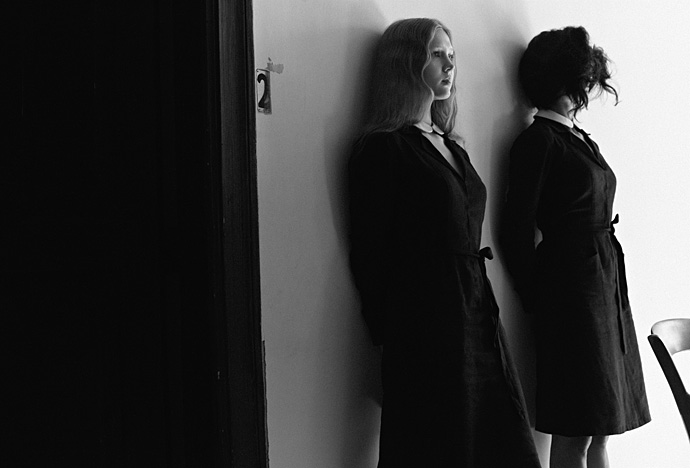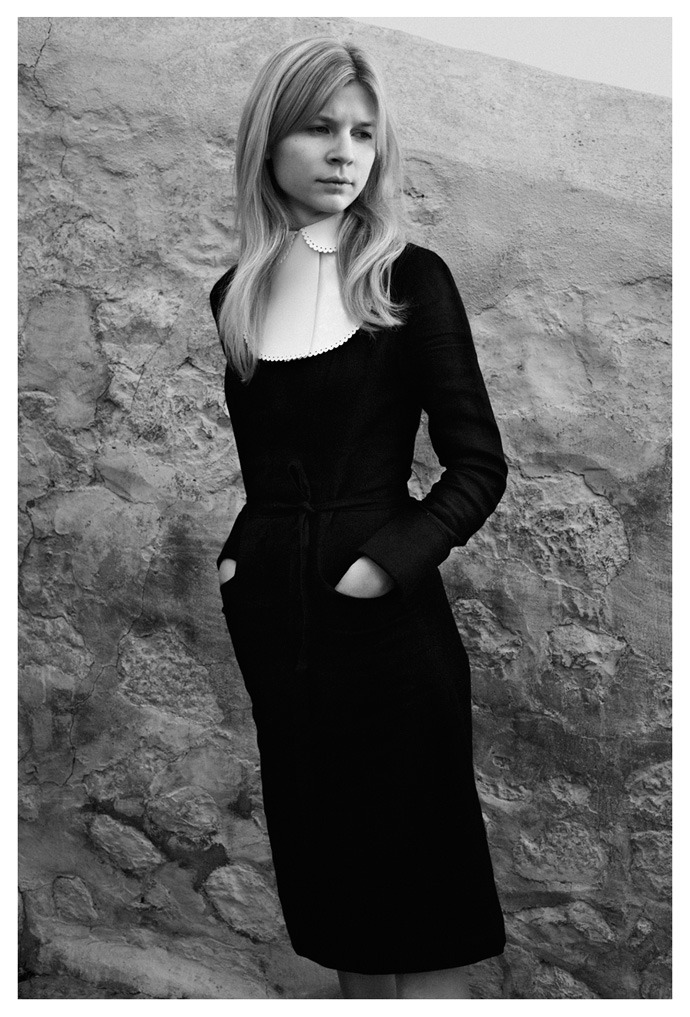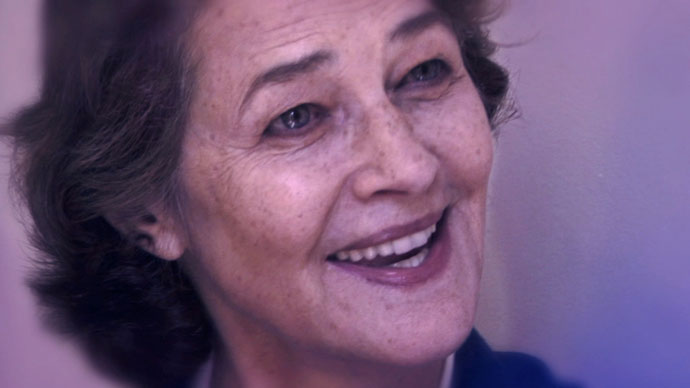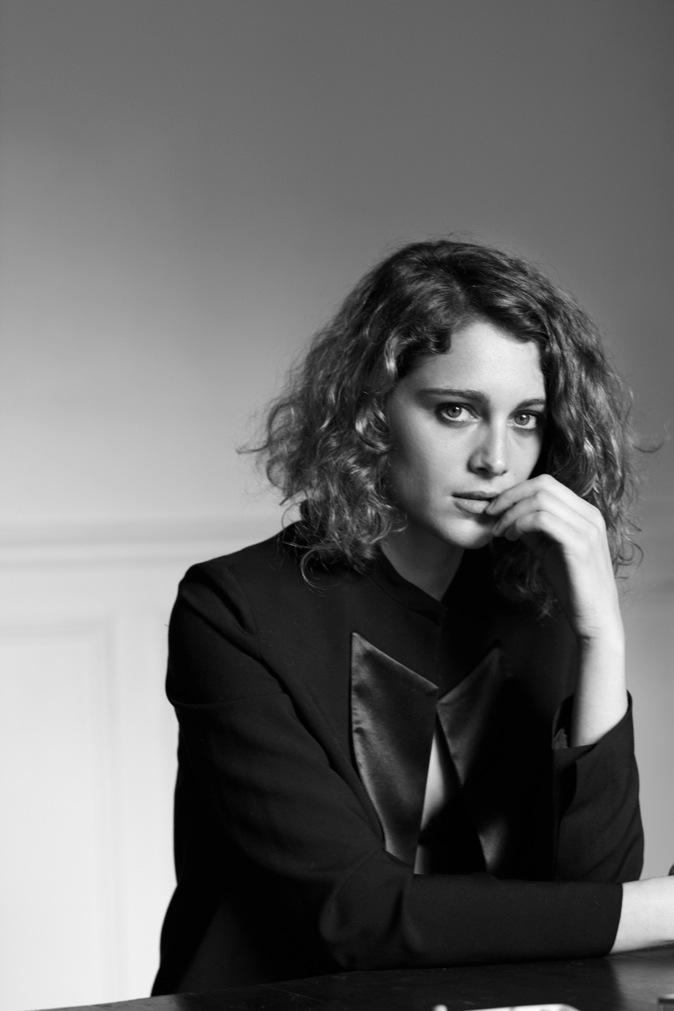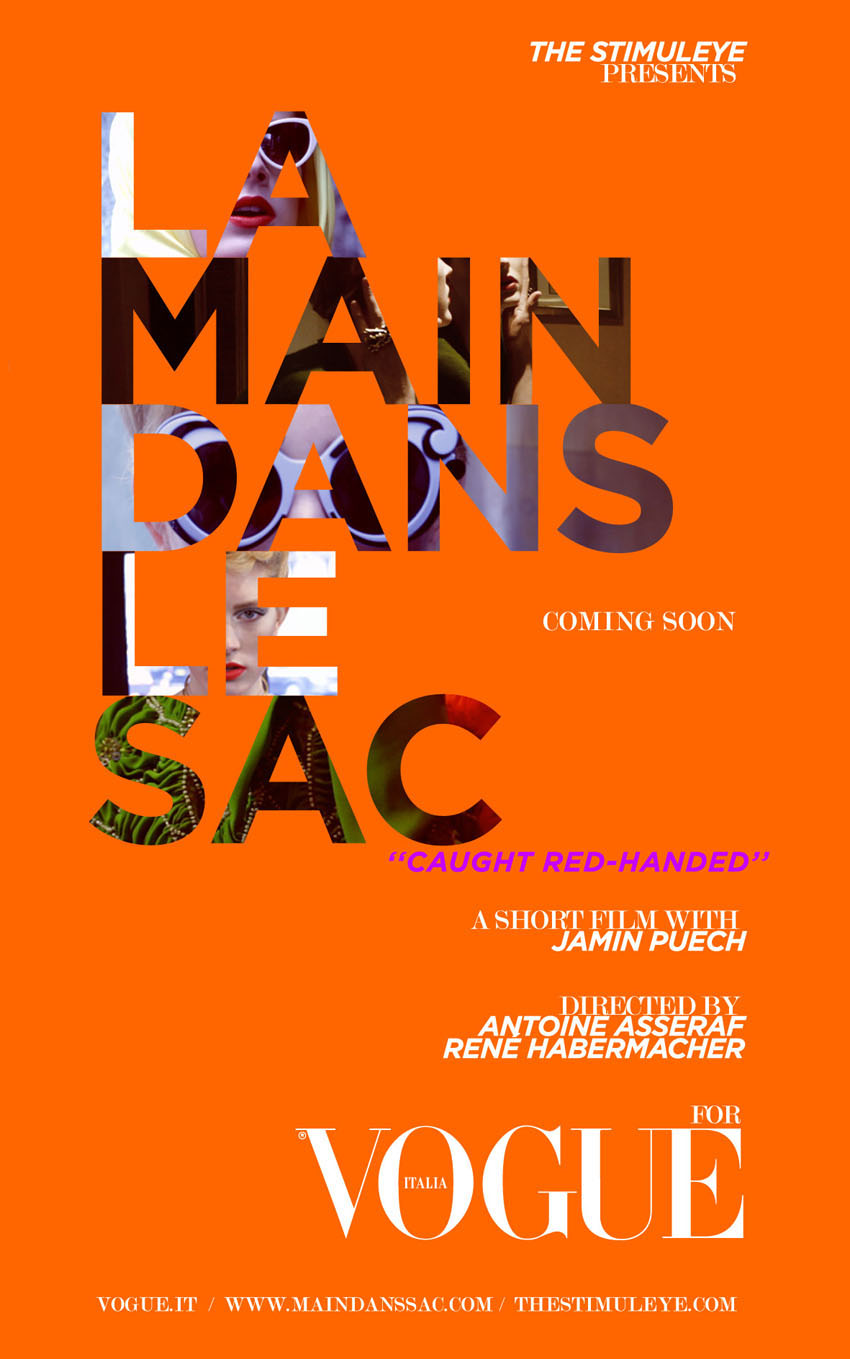-

Merry Xmas, Mister Sakamoto.
- Manuscript to the score of "Furyo" by Ryuichi Sakamoto. Photography René Habermacher.
Manuscript to the score of "Furyo" by Ryuichi Sakamoto. Photography René Habermacher.It doesn’t quite add up.
There are the many facets of Ryuichi Sakamoto, but putting them together, you still wouldn’t get a sense of who the man is.
He is both an icon of Japan’s 1980’s Bubble Era, and the one who moved beyond Japan and away from the spotlight, a consistent experimentalist and accidental sex-symbol.
Founding member of the influential band Yellow Magic Orchestra, Japan’s answer to Kraftwerk.
Musical innovator for over 30 years, mixing synthpop, Okinawan traditions, sampling, bossa nova….
Screen-mate of David Bowie in the cult film “Merry Christmas, Mr. Lawrence” / “Furyo.”
Film composer for Almodovar, Oshima, Bertolucci, Oliver Stone and Brian de Palma.
Collaborating with David Byrne, Brian Wilson, Youssou N’Dour and the Dalai Lama.
Appearing in Madonna’s “Rain” music video.
Sampled by Afrika Bambaataa…and Mariah Carey.And last but not least, well before the Fukushima accident, a prominent activist in Japan’s anti-nuclear effort.
It doesn’t quite add up, and that’s really for the best, as we found out after spending an afternoon with him in New York City

 Left: inspiration board. Right: Ryuichi Sakamoto. Photography by René Habermacher.
Left: inspiration board. Right: Ryuichi Sakamoto. Photography by René Habermacher.The Stimuleye: When did you first feel personally concerned with the nuclear issue?
Ryuchi Sakamoto: Probably I started feeling anxious about it around the time of Chernobyl. Then I encountered the facts about the nuclear reprocessing plant in the northern part of Japan called Rokkasho. It was 7 years ago, pretty recent.
It’s not a usual nuclear plant, it’s to re-use, re-process used radioactive wastes. Through the processing, you emit hundreds of time more radioactive materials than the usual nuclear plant does. You get 365 nuclear plants in 1 village. Very dangerous.
So I started a web campaign, called Stop Rokkasho, I asked Kraftwerk to give us a sound logo, and they did actually ! The pretty famous graphic designer Jonathan Barnbrook had his assistant design the webpage, which was very neat.
As a web campaign it succeeded, my friends – photographers, musicians, stylists, creative people got to know about this plant. We decided to make a Stop Rokkasho tshirt, we asked more than 50 designers to make a tshirt. They needed phrases, so I gave them “No Nukes. More Trees.”
Everybody loved it, especially the second line.
It’s very easy to understand, and no one can resist.So, I decided to form a company called “More Trees”, it’s been 6 years, and we’ve been doing mainly conservation of Japanese forests. We have now 11 forests in Japan and 1 in Philippines.
(more…)10 -

charlotte rampling
- -

i am a very lazy man : yohji yamamoto
-“i am a very lazy man.”
That’s not really the first thing that comes to mind when you think about Japanese designer Yohji Yamamoto.
Film costume designer, Hyères jury president, Y-3 sportswear line creator, musician and soon film director, not to mention one of the people who revolutionized fashion aesthetics, Yamamoto has done his share.I had the pleasure of spending an evening backstage at his fashion show to get an exclusive peek for the new Joyce.com website.
Antoine Asseraf for Joyce.com, interview by Lucienne Leung.
Thanks: Coralie Gaultier, Filep Motwary.
-

films of the season: monsieur chypre
-An erotic fashion epic, one year in the making, THE STIMULEYE is proud to present Monsieur Chypre – A Short Film With Erotokritos, coming April 11th on Vogue Italia.
Starring Constantino Kouyialis & Loan Chabanol, styled by Michaela Dosamantes, and directed by Antoine Asseraf & René Habermacher.
“He knows women, and women know him.”
Erotokritos, it’s a strange name for a fashion brand.It’s an even stranger name for a person.And yet, he is truly called Erotokritos Antoniadis, named after the main protagonist of medieval epic poem, a hero “born from the labors of love”. For 15 years, his label has been seducing women of all ages, drawn to collections that go back and forth between the sophistication of Paris and the dolce vita of Cyprus…“They call him Monsieur Chypre.”
France and Cyprus, Paris and Nicosia, it’s a long-distance couple.In Monsieur Chypre, by Antoine Asseraf & René Habermacher, they come to life: Loan Chabanol, channeling the nostalgia of Marguerite Duras’ The Lover, plays the tormented Parisian woman, cracking at the surface, while Constantino Kouyialis, in his first first on-screen role, is a revelation as the seductive eponym hero, a modern day Alexis Zorbas.“An erotic fashion epic” we call it.“Erotic,” how could it not be with a name like Erotokritos ?“Fashion,” of course: stylist Michaela Dosamantes, fresh from winning Best Fashion Award at La Jolla Fashion Film Festival for La Main Dans Le Sac, mixes the season’s classic looks to capture the heroine’s transformation from “bluesy” in Vuitton to “red-hot” in Valentino.And “epic” ? What else do you call a fashion film 10 months in the making, taking place not only in Paris but in numerous locations in Nicosia, in the salt lake facing the Hala Sultan Tekke mosque in Larnaca, in the Almyra and Anassa deluxe hotels, in small taverns by the side of the road, or in the majestic monument carved directed in the stone, the tomb of the Kings in Paphos ? And we haven’t even mentioned the upcoming almost 10 minutes long directors’ cut….“His voice is a song.”
All this, to the original soundtrack of Lori Schonberg and Shane Aspegren, members of transnational surrealist indie outfit The Berg Sans Nipple.So, now the tough questions.Is Cyprus really like this ? A little bit. Not at all. It depends how you look at it.It is an island of freedom in the east mediterranean, where couples from Israel and Lebanon come to escape religion. It is the birthplace of Aphrodite. You go, you decide.So how can I meet this Mister Cyprus ? We hear that one a lot. From women (and men) of all ages. Maybe he’s real, maybe he’s a figment of our collective imagination, our repressed desires. One thing’s for sure — we can’t give you his number.“Attempting to charm him is useless. He is the one who will find.”MONSIEUR CHYPREa film by ANTOINE ASSERAF & RENE HABERMACHERa THE STIMULEYE productionSTARRINGCONSTANTINO KOUYIALIS as MONSIEUR CHYPRELOAN CHABANOL (ELITE) as MADEMOISELLE PARISPARIS UNITSTYLING – MICHAELA DOSAMANTESHAIR – ROMINA MANENTIMAKE-UP – TIINA ROIVANENPRODUCTION ASSISTANT – LYNSEY PEISINGERLOCATION – HIROMI OTSUKACATERING – EROKITCHENVOICE by LYNSEY PEISINGERMUSIC by LORI SCHONBERG + SHANE ASPEGRENPOSTPRODUCTION by THE STIMULEYECYPRUS UNITALSO STARRINGMYRTO KOUYIALISDIVA MODELS:ALEXANDRA BUNETSKAYAKLELIA YIASEMIDOUANNA DOROTHEOULOCATIONS:ALMYRA & ANASSATHANOS HOTELSALL CLOTHES CYPRUS: EROTOKRITOS ARCHIVESPARIS CLOTHES featuringLOUIS VUITTON, EROTOKRITOS, LOUIS VUITTON JEWELRY, APERLAI, MARC JACOBS, DIOR, FELIPE OLIVEIRA BAPTISTA, AURELIE BIDERMAN, OLATZ, KIKI DE MONTPARNASSE, BURBERRY AND VALENTINOTHANK YOUDimitris Dimitriou / Cyprus Tourist Organisation in ParisPhilippos Philippou / Cyprus AirwaysPavlos Metaxas / Diva modelsAntonakis BarEleni ChrysostomidouLida PhilippidouMary NicolaidouMaroulla AntoniadouGallery Argo NicosiaKostas MantzalosThe city of NicosiaThe city of PaphosANDFilep Motwary -

films of the season 2: My Garden starring Kiko Mizuhara
-Part 2 of our spring fashion film series takes us to Vietnam, a land of mysterious fruits and exotic flowers.
Norwegian Wood actress, Towai Tei-singer, and model Kiko Mizuhara lets us into her garden,
for Vivienne Tam. -

must see: guy maddin’s spiritismes
-Damned movies, cinema legends, performance, a trance…
Guy Maddin’s new project at Centre Pompidou, featuring Ariane Labed and other stars such as Mathieu Amalric, Amira Casar, Udo Kier and Charlotte Rampling, has all the right ingredients, and best of all, is open for all to see.
 Collage by Galen Johnson for SPIRITISMES.
Collage by Galen Johnson for SPIRITISMES.Cult Canadian film-maker Guy Maddin invites anyone in Paris or with an internet connection to follow him and his actors live as they meditate and then shoot lost, unreleased or unfinished films by the likes of Hitchcock and Eric von Stroheim…
More info on the Pompidou Center website.
Follow the shoot live with 3 cameras on the Nouveau Festival / Spiritismes website.
-

ariane labed
-She’s French, but she acts in Greek.
ATTENBERG was her first film, but it won her a Lion at Venice in 2010 for Best Actress,
and the admiration of Quentin Tarantino and Sofia Coppola.
She loved the shooting, but hated the fame which followed.Introducing Ariane Labed in
ARIANE
an exclusive film by Justin Anderson,
in collaboration with THE STIMULEYE and Giorgio Armani,
and original pictures by René Habermacher.ARIANE, directed by Justin Anderson. Clothes - Giorgio Armani. Furniture - Armani Casa. Commissioned by THE STIMULEYE.
Antoine Asseraf : Bonjour!
Ariane Labed: Bonjour!
Are you currently in London ?
Yes, finally! I was supposed to move to London last September, but I’ve been moving around nonstop!
Do you often go back to Greece ?
I was in Greece in November to play with my troup VASISTAS, but now I’m more between Paris and London.
When did you first come to Greece, and what was your impression of the country at the time ?
I arrived in Greece 3 years ago, for a 9-month project of my troup with the National Theater of Athens, to put on a Faust.
I was born in Greece, lived there until I was 6, and I think I left part of my childhood there.I dreamt of returning. When I met Argyro Chioti in college, a Greek theater director with whom we created the troup VASISTAS, I jumped onto the opportunity of going.
So instead of 9 months, I stayed for 3 years, meeting Athina [Rachel Tsangari] and Yorgos [Lanthimos] had something to do with hit. Beyond a purely sentimental attachment to this country, I was impressed by all the artists I met and their urgent need to create. Without expectations of getting anything in return, beyond any judgement to which they could be subjected, beyond thinking about breaking even.
If I have just left, it’s only because I need to live in a country where I feel foreign, where I lose myself in the streets. That’s what I’m doing in London. The day where I won’t lose myself anymore, I will leave again.
But I will always return to Greece.
Ariane Labed by René Habermacher.
The films of Yorgos Lanthimos and Athina Rachel Tsangari in which you starred have universal resonance, but we can nevertheless imagine that they come in a context, in reaction to precise things happening in Greek society: the influence of the Orthodox church (the impossibility of cremation), the need to break the myth of Greece as a postcard-perfect location (the desolate landscapes of Attenberg)…
As you said yourself the Greek audience doesn’t really support these films, and when reading the article in THE GUARDIAN regarding New Greek Cinema I found the comments left by the Greeks to be very virulent – do you think the films play a role in questioning Greek society ?
If Greeks have a difficulties situating themselves in films such as Dogtooth or Attenberg, it may be because they carry a truth about their country which hurts.
This young generation carries with them the failure of the previous generation, a generation who thought they offering through a notion of “progress”, and after the military dictatorship, a better life, without taking into account the contradictions of orthodox culture and the desire for revenge after several centuries of hardship when the Greek people were a strange gate to the East.
Being French, I love all these contradictions about Greece, but that is also where the complexity lies, and these are facets which the new generation denies or which the previous cannot accept.
What I also love in Greece is that it’s non-colonial, as luckily they could never afford to be colonial, but it is painful to see and hear the Greek racism against the recent wave of immigration. I think the Greeks are overwhelmed by a lot of things today, and it’s evidently linked to the government which “enjoyed” European aid for decades, including the Olympics of 2004.
Though all this is probably only the beginning of what is slowly happening all over Europe.
ATTENBERG by Rachel Athina Tsangari - Trailer. Best Actress award at 2010 Venice International festival.
The beautiful thing about this chaos is that, these artists, without means, who expect nothing from the government, find the strength to meet and trust each other enought to creat together. That’s the case for HAOS, the production company created by Athina, which led to collaborations with Yorgos Lanthimos on DOGTOOTH and ALPS, and EMBROS, a new squat which just opened and brings together theater, danse, performance, critiques, writers, etc… Greek artists have never collaborated as much as they do today.
Of course the films of Athina [Rachel Tsangrai] and Yorgos [Lanthimos] carry and will continue to be denounced by a society which closes its eyes, much like other Western socities. That may be why they are recognized abroad but considered “weird” and barely tolerated in their home country. The taboos touched upon in Attenberg – death, cremation, incestuous desire, lesbian sexuality, are topics on which one can hardly have a dialog in Greece.
But it is difficult for me to criticize Greece… Beyond the corruption of the government and the misery into which it has dragged the people, which I can intellectually denounce, there remains for me an unspeakable element, a vibration I feel only there. A chaos which I find appeasing.
Ariane Labed by René Habermacher.
How did you live this experience of the “fashion film”, between actress and model, with Justin Anderson ?
I was quite reticent at first… but once I met Justin [Anderson] and he told me the concept, with the slow motion, I became quite excited. In the end it was a beautiful experience.
What are your current projects ? Can you tell me about your play with VASISTAS ?
The big news is that I’m about to shoot a film in France. The first film in my native tongue !
It took quite a while for people to figure out I’m French. My first 2 films, ATTENBERG and ALPS, are both in Greek, so everyone thought I was Greek. It doesn’t bother me at all, but really it’s quite a different exercise to play in a foreign tongue.
Congratulations. Are the plays with VASISTAS also in Greek ?
I’ve worked with my troup for 5 years now. We are 3 women: 1 Greek, 1 Mexican and myself. We met in college at Aix-en-Provence and created a troup. We work in different languages, centering on the body, on the impossibility of communicating with words. We don’t work from existing plays but rather from an editing of texts ranging from Deleuze to advertising… I play in French most of the time, but the text is there to relate to meaninglessness… My work is rather physical.
So it’s your own creations ?
Yes. The last show was called “spectacle” [“show”]. www.vas.eu.com
This impossibility to communicate is also an important theme in Attenberg, your character is very physical but has difficulties communicating with others —did your theater experience push the role in this direction or was it already thought out this way ?
The writing of Attenberg didn’t change much…but it wasn’t written for a foreigner, so maybe inadvertently we pushed this Marina towards another manner of communicating. Certainly, with Athina we didn’t want to approach the character psychologically. There’s always a great deal of physicality in my approach.
Ariane Labed by René Habermacher.
Where does this physicality come from, is it because you’ve practiced ballet, or did you practice ballet because it was in you ?
I did 10 years of classical ballet. I stopped when I was 16 because I could no longer stand the way the body was dealt with. It’s a strange contradiction, I was and remain persuaded that ballet is a sublime and fair form of expression, but I can’t deal with the instrumentalised body. In ALPS, I play the role of a competitive gymnast, it was a superb challenge to have to return to this physical condition, and yet a real nightmare !
So you keep this tension within you, between the habits of ballet, the need to express yourself physically, and the rejection of the classical dance system….
Yes, something like that.
When we spoke for the first time by email over a year ago, I wasn’t aware that you were at the time going through a “reaction”.
Reaction?
Reaction, or crisis, ou questioning ?
Was it the reaction to cinema ? to the success of Attenberg ? or to the rigors of a gymnast’s discipline ?
Yes, it was shortly after my award in Venice… I was lost. I did not know how to deal with anything — I didn’t expect and wasn’t prepared for such a level of display. I locked myself into work (the preparation of the role in ALPS) and fled the journalists. It took me a long time to realise that it could be a gift in my life.
That’s when I decided to get an agent in Paris to continue film-making. When I made Attenberg, I didn’t think I had a place on a screen. I’d loved the shooting, but I couldn’t picture myself fitting in. This award led me to hope I could continue, and now I only dream of shooting again.
Before Attenberg, was there something you found repulsive in cinema, or was it an attachment to the physicality of theater ?
I didn’t think you could find the intensity you have in front of the public. That moment when you lose the notion of time.
And paradoxically what troubled you after Attenberg was the intensity of the public scrutiny !
Being exposed in a work of art has nothing to do with being exposed as yourself holding a world cup trophy.
I can be naked, raw, give myself completely for a scene or a film, but to expose myself as Ariane Labed in the press is something I find completely uninteresting.
ALPS by Yorgos Lanthimos - trailer. Best Screenplay at 2011 Venice International festival.
So it’s rather the status of the “star” that troubles you rather than shooting itself ?
Shooting is sublime. But I’m not sure of what the actress’ status is. I don’t think there’s a rule. It’s a crazy job, and I hope you can go about it your own way. At least that’s what I’m trying to do.
You returned to Venice for ALPS, which won the prize for Best Scenario, how was it this time ?
It was a holiday ! I took a lot of pleasure, and I was very happy for Yorgos Lanthimos and Efthimis Filipou [the writers].
Let’s quickly talk about ALPS – when does the film come out ?
In France I’m not sure, but in the UK in the Spring.
How was this second film for you ?
I was afraid. After the success of Attenberg, I put a lot of pressure on myself… I was telling myself again that maybe Tarantino was wrong, maybe I shouldn’t be on screens anymore….but it helped me to work even more. It was a small role in ALPS, but which required 3 months of intense preparation, so I tried to make the most of shooting days and give my best. It was a very different experience. Yorgos doesn’t work like Athina at all, he leaves the actors with a lot of doubt, and captures everything that slips through.
-

new greek cinema: of WASTED YOUTH and “an old whore in need of love”
-These days we hear mostly troubling news from a country to which its citizens proudly refer to as “the birthplace of democracy”: Greece. Another spiral of economic turmoil unfolding in slow motion casts a spell upon Europe. And yet accelerated by the recent events, a very different wave reaches us from this troubled country: “The weird wave of Greek Cinema” as The Guardian’s Steve Rose titles. The Stimuleye talks to WASTED YOUTHS director Argyris Papadimitropoulos.
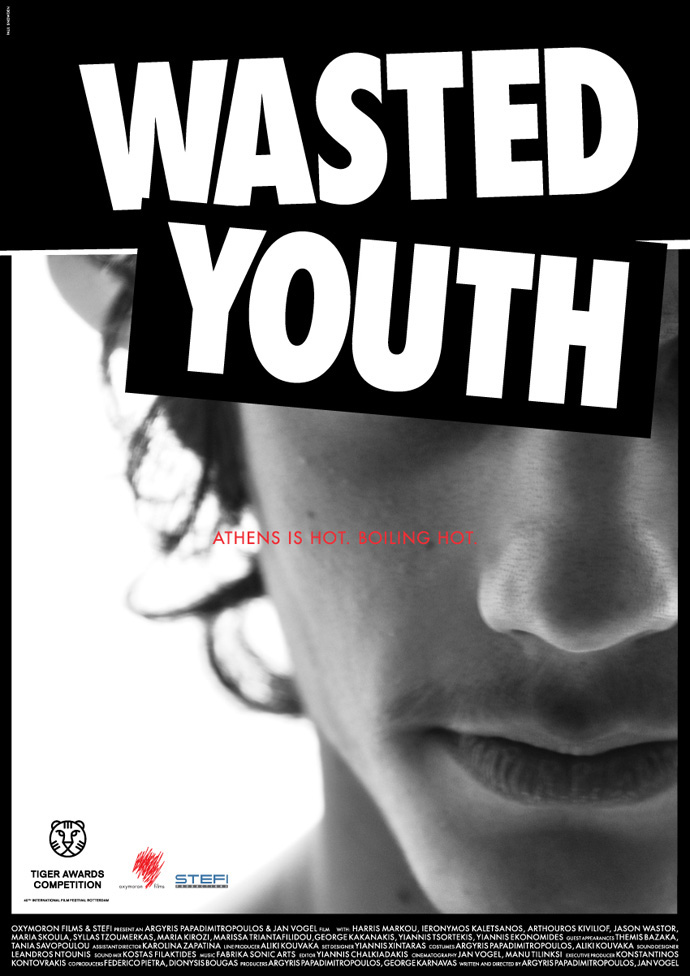 Poster for WASTED YOUTH
Poster for WASTED YOUTHIt’s the late days of summer 2011. A handful of Athenians, foreigners and expats mingle on Antiparos, a small island in the wide open of the blue Aegean. Athens is far and its troublesome agenda on a halt.
As the night falls scenting the breeze with jasmine, the open air cinema Oliaros, a local institution, announces tonight’s screening with notices on poles and walls: WASTED YOUTH, the film that earlier this year had opened Rotterdams Film Festival. The film’s director, Argyris Papadimitropoulos, hands stickers to the arriving guests: WASTED, MALAKA (wanker), YOUTH, LOVE….The film is set during a hot summer day in Athens. Much like the city itself, exhausted, confused, unable to make any progress, brimming with desperation and aggression, there is Vasilis, a middle-aged man struggling with the mounting stress to cater his family. On the other side Harry, a sixteen-year-old skater. He and his friends are amusing themselves and wasting time away. Their lives intersect in a contemporary portrait of the city of Athens and a society in crisis.

 Left: director Argyris Papadimitropoulos at Antiparos and right: Poster of cinema Oliaros with MALAKA sticker
Left: director Argyris Papadimitropoulos at Antiparos and right: Poster of cinema Oliaros with MALAKA stickerRENÉ HABERMACHER: How did that screening at the open air cinema come together?
ARGYRIS PAPADIMITROPOULOS: I am a regular there so I know the guys of Oliaros cinema since… forever. They asked me to do a screening and although I was not allowed to do so by my distributors – In Greece films are supposed to have two runs since we have this open air cinema tradition still alive and very popular – I couldn’t say no. I just love this tiny cinema, and the fact that it is free for everybody to watch the films. There are Greek islands much bigger in population who do not have a cinema and that’s sad.
There’s such a huge part of me and my adolescence in WASTED YOUTH that in every screening I still feel kind of weird… weird in a good way. Since I re-lived my teenage years by shooting this film I feel so exposed. It’s strange telling unknown people so many things about myself. But that’s the magic of it, isn’t it?
WASTED YOUTH had its world premiere in Rotterdam Film Festival in January 2011 and was also honoured to be the opening film. Since then it was screened in more than 30 festivals around the world. In some of the best actually. It was a great year, I spent much of it traveling and presenting the film.
We signed with Elephant Eye Films in New York to represent WASTED YOUTH for world sales. For such a tiny budget film I can loudly say: we did great.Trailer of WASTED YOUTH
R: How was the film generally received by the international audience?
A: I’m more than happy with the comments audience and critics wrote about it.
Screen International described it as “lush, evocative and impressively shot” (laughs).By its career you can tell that the film was received excellent. The audience loved it and the few that hated it, were the ones that gave me the chance to talk, start a discussion, which back in the beginning was the main intention for the film.
I was with my friend and co-author Jan Vogel and we were saying that we need to make a film about these crazy days we are going through and that we need to do it NOW. Some films are made with a sense of urgency. We actually didn’t spent any time writing scripts or searching for funding, but found our amateur teen guys and a couple of good actors and started improvising on a few pages, something like a synopsis. WASTED YOUTH was privately funded by friends and is what you would call 100% indie.R: So it was pretty much a “hit and run”?
A: It was a hit and run urban guerilla thing but shot on film (!), not digital.
 Over the edge: Still from the movie WASTED YOUTH: Harry (Harris Markou) skates in the empty pool of his parents friend.
Over the edge: Still from the movie WASTED YOUTH: Harry (Harris Markou) skates in the empty pool of his parents friend.R: I really liked the scene in the very beginning when the boy wakes up in the morning, somewhere in this modernist building…. that whole sequence to the skating in the empty pool felt really strong… like frozen time.
A: That was our intention. We wanted to go through all the different people, classes etc in the modern greek society.
So the kid wakes up in a house of a lady with what we call “old money” and starts his day under the surface of the earth.
We wanted to have our little symbolisms without making a mind-fuck film.
There a second levels, second readings etc but only for those who want to read them.
I hate the films that are so personal that you will not get them unless you are the person itself (laughs).
I love stories.
I hate smart ass films.R: In my eyes your film looked very authentic- which is quite difficult to achieve.
A: Glad to hear! That was what we wanted to do: a spontaneous film!
R: In a way it also gives a beautiful portrait of the city. How do you like Athens?
A: I love Athens. It’s the place that i was born and I know it as the back of my hand. Athens is a character itself in the film. Its chaotic , crazy and sadly neglected.
It’s the old whore that people love to hate but they love paying a visit. Athens needs a bit of love from the people that fuck her everyday.
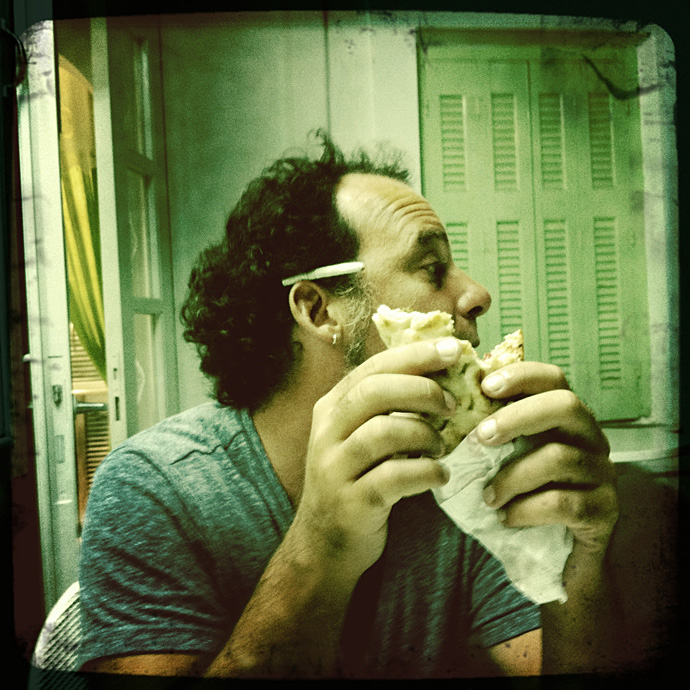 Argyris getting down with more from the spit
Argyris getting down with more from the spitSPOILER ALERT(for the affectionate reader who has not seen the film yet, please skip this part)
R: I was quite surprised at the end when the final “shot” was triggered by the other police man
A: by that I wanted to say that anybody would have done it.
I wouldn’t like the audience to leave the screening and feel sorry about a killer,
since the cops carry guns one day they will trigger them.R: Thats why you left him blank? as a character
A: True, if by blank you mean what I mean.
END SPOILER ALERT
 Still from WASTED YOUTH: Athens
Still from WASTED YOUTH: AthensR: The Guardian wrote an article on what they call the “weird wave of Greek cinema”…
A: the fact that the Guardian ran a huge piece on Greek films is already impressive.
A few years back they wouldn’t spend ink on this. That means that there’s something great being born here. I wouldn’t call it a wave and wouldn’t rush to give it names but you can smell something good is going on. There’s no surprise anymore when you see a Greek film in the list of a great festival.
Berlin, Rotterdam, Cannes, Locarno, Venice, Sundance, you name it.
Critisism is there and will always be, there are some people that are sceptical about whatever new is going on and others that want to kill it before it even gets born.
People are not ready for changes, you know.It seems like when societies are on the edge, edgy things come out of their arts. Remember Argentina, Romania and so on.
What was happening in Greece the last 25 years, let’s say from the early 80’s till the olympics was a fake paradise:
a fake prosperity with fake money, fake happyness, fake tits, fake, fake, fake …A fake new identity that never made it to the core of neither our souls nor our society – it collapsed in a few days.
One day they told people we are in crisis and people believed it the same day, so there were no solid foundations in this “new order” that was fakely established. Still from WASTED YOUTH
Still from WASTED YOUTHR: To come back to one of the most interesting things about the article of the Guardian, it were the comments by fellow Greeks being often malevolent, accusing the directors of plagiarism in the case of Dogtooth, or calling the films “a product of mental health problems”.
A: hahaha! that’s great fun.
People cannot accept themselves. When somebody puts a mirror in front of them they can’t cope.
A product of “mental health problems” is the society we use to live in, so are the films as they are suppose to reflect the society.
As for the plagiarism: I would just say that there were very few people saying so, but they created a huge buzz. These people are the ones that do not like the success of someone else because they are stuck in their thing.The greatest festivals in the world are not stupid to have a work of plagiarism in their catalogue.
Also, plagiarism in art is a huge topic that it is almost impossible to discuss: almost every great artist was accused of that!
 Argyris at his favorite souvlaki place in Antiparos.
Argyris at his favorite souvlaki place in Antiparos.R: I thought this was a very typical reaction. In a recent article for Vanity Fair Michael Lewis puts it like that:
Individual Greeks are delightful: funny, warm, smart, and good company. I left two dozen interviews saying to myself, “What great people!” They do not share the sentiment about one another: the hardest thing to do in Greece is to get one Greek to compliment another behind his back. No success of any kind is regarded without suspicion.A: I wouldn’t agree. If you look at the end credit of all this films that made it to the great festivals the last few years, you will realise that everybody helped on each others work. Greeks are easy target to be accused for almost anything since we have this fucked up temper. But on the other hand you can tell that there is still solidarity and support between most of my fellow greek film makers for example.
R: What are you working on next?
A: I write a couple of scripts with friends. Things are hard these days but we’ll keep trying.
I would like every film I make to be so much different from the other. I would also love to make a film abroad, although I love Athens.
Paris, London, Berlin, New York, Rio, Buenos Aires – there are stories everywhere that i would love to tell… Still from the movie WASTED YOUTH: Harry (Harris Markou)
Still from the movie WASTED YOUTH: Harry (Harris Markou) -

coming soon – CHIARA SKURA
-Hot on the heels of Marios Schwab’s breakthrough SS12 collection “chiaroscuro”, The Stimuleye is proud to announce “CHIARA SKURA – A Short Film With Marios Schwab” for Vogue Italia, coming September 28th…
Directed by Antoine Asseraf & René Habermacher
Starring Amy BaileyMarios Schwab
Style.com show pictures and review
Vogue.it – A Short Film With -

Presenting… LA MAIN DANS LE SAC / CAUGHT RED HANDED
-For your embeddable pleasure, a story of bags, fashion, crime, and more bags, commissioned by Vogue Italia.
Who is hiding behind those Prada shades ? What is she doing ? Will she get caught ?
THE STIMULEYE
presentsA Short Film With
JAMIN PUECHfor
VOGUE ITALIALA MAIN DANS LE SAC
“Caught red-handed”Directed by
Antoine Asseraf & René HabermacherStyling by
Michaela Dosamantes
Assisted by
Alexia HollingerStarring
Quinta Witzel @ IMG ParisMake-Up
Tracy AlfajoraHair
Romina Manenti @ Airport
Assisted by
Masako HayashiFilmed at
Prunier, ParisMusic by
Shane Aspegren & Lori Schonberg
of
The Berg Sans NippleThank You:
Lisa Kajita
Nicolas Barruyer
Erotokritos Antoniadis
Yoann Lemoine -

a screen within a screen – SUZIE Q & LEO SIBONI
-They’re not even close to turning 30.
And yet they are releasing their third fashion film superproduction, IS THIS REAL LIFE for designers Mastori and Motwary, on Vogue Italia; and doing the cover story for UNDER THE INFLUENCE, out on Friday.
They are… Suzie Q and Leo Siboni.
 THE HEALING POWER OF ELECTRICITY, in UNDER THE INFLUENCE magazine, by Suzie Q & Leo Siboni.
THE HEALING POWER OF ELECTRICITY, in UNDER THE INFLUENCE magazine, by Suzie Q & Leo Siboni.Antoine Asseraf: how did the two of you meet ?
Suzie Q & Leo Siboni: We met while studying at Ecole des Gobelins, Paris, in 2005. At first we helped each other out for our personal projects, and then in 2007 we started working together.And what was your first project as a duo ?
It was a photo series for the fashion magazine DOUBLE, named SCREENPLAY. We used different films by John Ford, projected as a background.The idea was to establish a relationship between John Wayne and the model.
 SCREENPLAY, by Suzie Q & Leo Siboni.
SCREENPLAY, by Suzie Q & Leo Siboni.At Gobelins, did you both study photography ? And why did you start with fashion photography ?
Yes, we both studied photography. For us fashion is a way to experiment, fashion imagery is about mise-en-scène, putting the clothes forward.Paradoxically, what we like the most are the constraints.
It helps you create, pressures you to act quickly. It’s rather intense.
Funny that your photo series should be about cinema…
Cinema inspires us a lot. We work more and more with the idea of an image within the image, of a certain depth, a frame within the frame. In the end I think we’re attached to the idea of the screen.
(more…) -

justin anderson – not another dream sequence
-At last, at last. After an epic ping pong interview months in the making, here it is. Painter – turned video artist turned – precocious fashion film director Justin Anderson.
He has a bum fetish, just like everyone else.
BIKE by Justin Anderson, for Armani Jeans. Still by René Habermacher.
Antoine Asseraf: What is the last thing that stimulated you ?
Justin Anderson: On Friday night – I watched a film by Jean Pierre Melville – ARMY OF SHADOWS.It had a big effect on me. It is brutal but very paired down without any melodrama. None of the actors either particularly young or good looking, the direction is tight and the subject really tough. It is about the French resistance to German occupation – it is about death, betrayal and torture.
The film was gripping was absolutely masterful. What I love is that I discovered this film because I loved the way Alain Delon looked in LE FLIC in his raincoat – which then led me to such a film. I feel very lucky to live in a time in which it is so easy to discover these kinds of gems and I love the fluid way you can to move from one to the other.
So, which would you say are you main influences in film-making – classic films such as the ones you just mentioned, or more experimental fare ?
All kinds of image making influence me particularly fine art – which is how I trained. I would say the paintings of Fontana, Morandi, Barnett Newman, Stella, Ryman, the sculptures of Brancusi, Donald Judd artist like Walter de Maria. Dan Graham, Bruce Nauman were particular influence to me. These have all impacted on my filmmaking as much or more so than other film makers because that is what I studied for years. I suppose my taste currently in film making are as you say classics. I was hugely influenced by Buñuel when I was introduced to it as a 14 year old boy by a very good art teacher at school – he knew exactly how to stimulate a 14 year old boy.Currently I working my way through the classic European film makers of the last century, Bergman, Antonioni, Chabrol, Renoir and recently Melville. Having not studied film I feel like I have a lot to catch up on.
UNTITLED VIDEO STILL by Justin Anderson. Courtesy of Gerwerbe Karl Marx Gallery, Berlin.
So how did you transition from fine art – painting if I’m correct – to video ?
I started working in video quite along time ago whilst still studying at the Rijksakademie in Amsterdam. The work was structuralist and minimal – I chewed gum live on television for 5 minutes, made a video in NYC where I drew the lines of a huge tennis court across midtown Manhattan and the dove them with a camera attached to the roof of a car. The video camera was moved through space like making a drawing – instead of leaving a marking on the space you were recording what is there.I made a video of a guy dressed in protective sports gear standing against a wall and shouting “Just do it” in German whilst I served tennis balls at him as hard as I could. It was quite violent (our friendship ended soon after!).
At the time I was making very large paintings of the lines on parts of sports courts- it all seemed to flow from one to another- the video camera was just another from of mark making. The videos had virtually no editing and certainly no close ups or variants in the shots.
(more…) -

COMING JUNE 1ST
-One of the reasons we’ve been away recently… La Main Dans Le Sac, a film commissioned by Vogue Italia.
The Stimuleye presents
A Short Film With Jamin Puech
for Vogue Italia
“Caught red-handed”
Directed by Antoine Asseraf & René Habermacher
Styling by Michaela Dosamantes
Assisted by Alexia Hollinger
Starring Quinta Witzel @ IMG Paris
Make-Up by Tracy Alfajora
Hair by Romina Manenti @ Artlist
Assisted by Masako Hayashi
Filmed at Prunier, Paris
Music by Shane Aspegren & Lori Schonberg of The Berg Sans Nipple
Thank You: Lisa Kajita, Nicolas Barruyer, Erotokritos Antoniadis, Yoann Lemoine.
-

coming soon: la main dans le sac
-The Stimuleye is proud to announce its upcoming film for Vogue Italia, La Main Dans Le Sac.
Literally, “the hand in the bag”, as in “caught in the act”.Made in collaboration with bag makers Jamin Puech, the film will debut on Vogue.it’s A Short Film With section,
featuring original music by Berg Sans Nipple.LA MAIN DANS LE SAC
A Short Film With Jamin Puech ⎜ Directed by Antoine Asseraf & René Habermacher for Vogue Italia – Talents
Styled by Michaela Dosamantes Featuring looks by Prada, Jil Sander, Lanvin… ⎜ Starring Quinta @ IMG
Original soundtrack by Lori Schonberg & Shane Aspegren of the Berg Sans Nipple
Filmed at Prunier Paris -

EYE 2 EYE: la lutte de l’amour
-Caroline Daily interview of Antoine Asseraf about “La Lutte de L’Amour” (The Struggle of Love), the SS2011 film he made for Erotokritos.
Caroline Daily: what is the first film which made an impression on you ?
Antoine Asseraf: The most striking memory for me is David Lynch’s Lost Highway.
It was my first Lynch, and the mix of glamour and goth, the changes in personality, the concept of looping, free intepretation, all left me without voice.With David Lynch, there is always a staggering artistic direction, a mix of architecture, music, design and casting which create entirely novel worlds.
In a different register, there is also Danny Boyle’s Trainspotting, which left a mark because it’s such a violent film, but with an “english” type of violence – very different from the hollywood violence to which i had grown accustomed.



